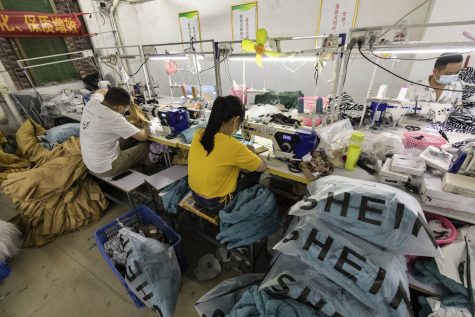The true cost of fast fashion
Fast fashion presents a humanitarian and enviornmental crisis.
Fast fashion brands have become increasingly popular among Generation Z (Gen Z) for their low prices and fast production. However, brands accomplish this through the mistreatment of their workers and damage to the environment. Consumers fail to acknowledge these unethical practices, which has caused brands to thrive. People need to become educated about the brands they support to eliminate fast fashion and its inhumane practices.

The term fast fashion describes the rapid production of high volumes of clothing and accessories. These clothing items tend to replicate trends and consist of low-quality materials, according to thegoodtrade.com. Many famous brands among Gen Z consumers use this method, such as Shein, Zara, and H&M. These brands tend to have low prices and fast production, which appeals to younger consumers. The companies also copy independent designers’ items and sell clothes of poor quality for a much lower price.
Fast fashion has exponentially increased over the last 20 years, according to panaprium.com. Consumers are willing to pay for imitations of high-end brands and low-quality pieces to stay on trend. However, staying “trendy” causes consumers to discard their clothes after a few uses, as new styles emerge weekly. In response to consumer demands, fast fashion brands keep pushing for increased labor and lower raw material costs.
Fast fashion has a substantial impact socially and environmentally, according to panaprium.com. In order to offer low-cost clothing, fast fashion retailers obtain garments from factories in countries where labor costs are inexpensive, like China and Bangladesh, according to thefashionlaw.com. For instance, behind Shein’s clothes are unethical practices and working conditions that violate China’s labor laws. The company pays its workers roughly 4 cents per item, and workers spend up to 18 hours a day manufacturing clothing items. If their workers make a mistake, Shein penalizes them two-thirds of their daily wage, according to thecut.com. While these companies earn millions of dollars, they exploit their garment workers. In the documentary The True Cost, author and journalist Ms. Lucy Siegle elaborated on the human rights concerns over fast fashion.
“Fast fashion isn’t free. Someone, somewhere is paying,” Ms. Siegle said in The True Cost.
Reducing the use of fast fashion will also help environmentally. The fashion industry is responsible for 8 to 10 percent of global carbon emissions, and this number is only increasing, according to unece.org. Purchasing these clothing items that people dispose of in a matter of weeks contributes to the environmental issue of waste disposal. These corporations send 21 billion pounds of textiles to United States landfills every year, according to shared-impact.com.

Unfortunately, fast fashion has become a part of the Gen Z style, but these young consumers must look for other ways to shop sustainably and recognize what occurs behind the products. People shop these brands mainly because of their low prices. Sustainable fashion options tend to have a higher price because of the fabrics, fair labor wages, and a higher-quality production approach. However, affordable options do exist, such as thrift stores and secondhand items. Purchasing a dress secondhand can save 21.4 pounds of carbon dioxide emissions while saving the consumer money, according to greenstory.io. Brands such as Honest Basics, Everlane, For Days, and Kotn use sustainable materials and ethical production, according to thegoodtrade.com.
This unethical manufacturing method persists because of the lack of awareness and media presence on this issue. Becoming well-informed about the problem is the first step to eliminating fast fashion. Looking for trend replication, rapid production, low-quality materials, manufacturers, and pricing when shopping can help identify fast fashion brands, according to thegoodtrade.com. With this knowledge, consumers have a responsibility to shop sustainably and shed light on illegal labor practices.
Featured Image by Caterina Pye ’23

After two years of writing and editing for the King Street Chronicle, Caterina is extremely excited to return for her final year as the Managing Editor,...


